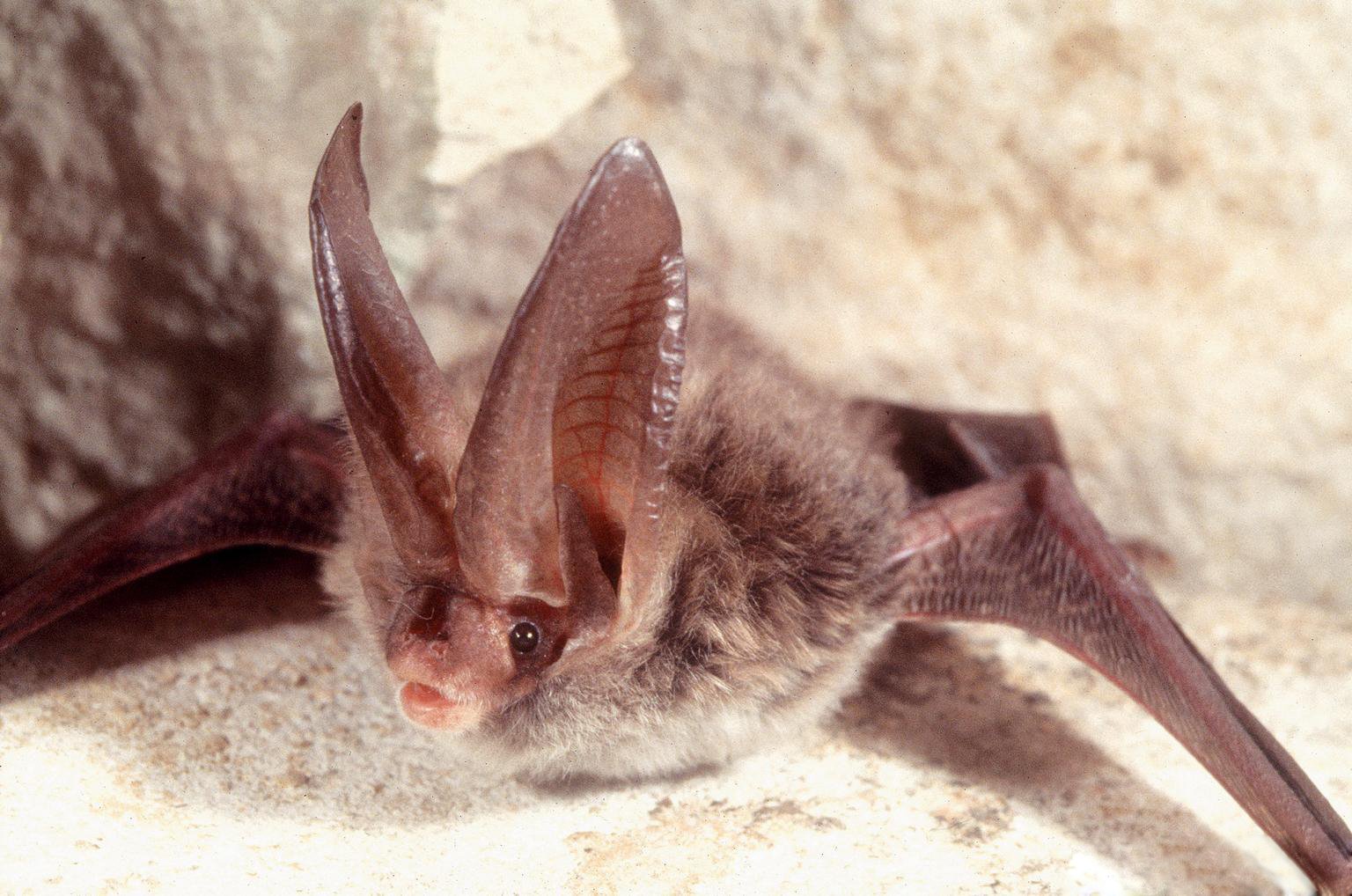Rafinesque’s Big-eared Bat: Corynorhinus Rafinesquii

A species of vesper bat endemic to the southeastern United States is Rafinesque’s big-eared bat (Corynorhinus rafinesquii), often referred to as the southeastern big-eared bat.
This bat species adapts to seasonal weather and alters its mating, hunting, and hibernation habits to fit weather conditions.
Although Rafinesque’s big-eared bats have been seen across the southeastern U.S., the species is still rare making it difficult to study all of the bat’s habits/tendencies.
Learn More: Common Bat Species
Physical Characteristics Of Rafinesque’s Big-eared Bat
The rafinesque big-eared bat (Corynorhinus rafinesquii) is a medium-sized bat (3-4 inches long, 10-12 inches from wing-tip to wing-tip). It weighs less than 1/2 ounce or equivalent to that.
The fur on the back is gray or dark brown and on the belly is ivory. On either side of it, the nose has two glands protruding. The ears are large compared to the bat’s overall size: they’re nearly half the bat’s length when laid back against the abdomen. 1Go To Source scwf.org -“Rafinesque’s Big-Eared Bat – Corynorhinus rafinesquii”
Rafinesque’s Big-eared Bat Behavior
Corynorhinus Rafinesque’s seasonal activities can be divided into fall swarming/mating, maternity colony establishment, and pup rearing/ hibernation.
The big-eared Rafinesque bats usually leave the roost long after dark and return before twilight in the early morning. To catch stationary prey, they are flexible flyers and can navigate across cluttered corridors and hover. Hunting strategies and roost patterns differ based on seasonal weather.
Roosting Habits Of Rafinesque’s Big-eared Bat
Starting in the early spring, and ending fall-winter months, mixed-sex roosts are occupied. Both sexes collectively inhabit day roosts as well as hibernacula. When roosting, Rafinesque’s big-eared bats cluster together and can range from 2 to 100 in the number of people, although others remain solitary.
The big-eared bats of Rafinesque hang upside down while roosting with the ventral side resting along a substratum. While roosting, these bats demonstrate grooming behaviors, which are believed to reinforce social bonds among conspecifics. There is no choice between genders in roost selection. Reproductively-active females assemble in maternity colonies and care for their offspring during the summer months.
In maternity roosts, roost fidelity is also seen, and these are used for several seasons, upwards of 5 to 10 years, depending on the roost’s structural integrity. Maternity roosts, including roosts in dead trees, under bridges, and abandoned human buildings, may consist of several roost locations. Depending on habitat quality and roost availability, the maternity roost system is typically composed of a primary home roost with many other satellite roosts. To migrate to various roosts, females fly with the young clinging to their ventral side. During foraging, this activity does not occur. Males and non-reproductive females also use day roosts in the summer months.
Rafinesque’s Big-eared Bat Swarming
The Rafinesque big-eared bats assemble in swarms during the fall months (September to October) and begin to mate. Outside cave entrances where mixed-sex roosts are found, these swarms typically occur.
The big-eared bats of Rafinesque usually do not share roosts with other bat species. However, these bats may sometimes roost with tri-colored bats (Perimyotis subflavus) and Virginia big-eared bats in the northern parts of their range.
Hibernation Of Rafinesque’s Big-eared Bat

In winter (November to February), Rafinesque’s big-eared bats hibernate for as long as three to four months to survive cold temperatures. Depending on the location and severity of the weather, the period of hibernation can differ from year to year.
Rafinesque’s big-eared bats can experience a state of torpor during the summer months in the northern portions of their range. If aroused, these bats can initiate immediate flight from a fixed location. However, it may take several minutes for bats to begin flight if aroused when hibernating. 2Go To Source animaldiversity.org -“Corynorhinus rafinesquii Rafinesque’s big-eared bat”
Rafinesque’s Big-eared Bat Habitat
Rafinesque’s big-eared bats are found in older growth bottomland hardwood forests of the southeast United States. These bats flourish in mature forests with plenty of mature, hollow, and roost-trees.
In a sort of hibernation called torpor, the trees act as sanctuaries where they spend winters and grow their young in the spring. The mature flooded forests have plenty of space between trees, providing the bats with ideal foraging habitat during the night to feed mainly on moths.
Rafinesque’s have rabbit-like ears that are important during hunting and nighttime navigation through the forest for echolocation. 3Go To Source fws.gov -“Rafinesque’s big-eared bat”
Range Of The Big-Eared Bat
Rafinesque’s big-eared bat is found in the southeast U.S., east to southern Virginia and North Carolina, including southern Indiana, southwest Arkansas, and eastern Texas.
Rafinesque’s Big-eared Bat Diet
The Big-eared Bats of Rafinesque are moth specialists whose remarkable agility enables them to skim insects from the foliage surface. In-flight, they can catch prey as well.
Their large, relatively short wings and lower-pitched feeding calls are ideal tools for feeding in areas like densely vegetated tree canopies. The species consume many kinds of insects, but 90% of their diet consists of moths, many of which are considered forest and agricultural pests.
Conservation Of The Rafinesque’s Big-eared Bat Species
Although widespread in the eastern U.S., this bat is not abundant, and population levels have decreased in the past century due to loss of summer roosting or foraging habitat and winter hibernacula disturbance.
The big-eared bats of Rafinesque are at particular risk as they establish nursery colonies or hibernate in caves vulnerable to recreational disturbance and abandoned mines slated for closure or reclamation. 4Go To Source batcon.org -“CORYNORHINUS RAFINESQUII”
Sources:
- Flamholtz, Hilda. “Rafinesque’s Big-Eared Bat.” South Carolina Wildlife Federation, www.scwf.org/rafinesques-bigeared-bat. Accessed 11 Dec. 2020.
- Titus, K. 2017. “Corynorhinus rafinesquii” (On-line), Animal Diversity Web. Accessed December 11, 2020 at https://animaldiversity.org/accounts/Corynorhinus_rafinesquii/
- U.S. Fish and Wildlife Service. “Rafinesque’s Big-Eared Bat.” U.S. Fish And Wildlife Service, 29 Sept. 2013, www.fws.gov/refuge/trinity_river/wildlife/bats.html.
- Bat Conservation International. “Corynorhinus Rafinesquii.” Bat Conservation International, 1 July 2020, www.batcon.org/bat/corynorhinus-rafinesquii.
